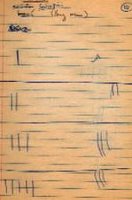Innate Numbers: One, Two or Many?
 "To what extent can concepts exist without the words to express them?" So begins an editorial from Science on an article describing a small, isolated Brazilian tribe known as the Piraha. This tribe has no currency, no art, no more than 10 consonants and vowels, and incredibly no words for any number greater than two. In fact, even the words used to indicate "one" and "two" are considered very approximate indications of quantity. Phonologically, they differ from each other only insofar as one is spoken with a falling tone, while two is spoken with a rising tone.
"To what extent can concepts exist without the words to express them?" So begins an editorial from Science on an article describing a small, isolated Brazilian tribe known as the Piraha. This tribe has no currency, no art, no more than 10 consonants and vowels, and incredibly no words for any number greater than two. In fact, even the words used to indicate "one" and "two" are considered very approximate indications of quantity. Phonologically, they differ from each other only insofar as one is spoken with a falling tone, while two is spoken with a rising tone.This oddity is not purely linguistic, however: members of this tribe are also deficient in matching the number of hatches on a sheet of paper when they outnumber 3 (see picture), in remembering quantities over a delay, and even in discriminating between different numbers of items greater than 3. This is seen as evidence against the strong "number sense" hypothesis, instead supporting that only very limited representations of number are innate to humans, just as in animals.
The author of this study, Peter Gordon from Columbia University, believes that this shows language is not merely a reflection of how humans think, but that language itself can profoundly constrain thought. At least for the concept of number, the Whorfian hypothesis would appear to be true: humans who are not exposed to a number system are not able to represent exact quantities. But ignoring the obvious epistemological problems (how did the concepts of number ever emerge, if this tribe was unable to evolve them in isolation?) it is likely that this tribe is an unrepresentative sample with which to gauge innateness, given their other cultural idiosyncracies. Indeed, even preschoolers have been seen to consider numbers as specific quantities.
Certainly there is a nonverbal, nonspecific, innate representation of number or magnitude that is not affected by language - this is supported by clinical studies of humans with profoundly impaired language skills yet spared numerical skills (e.g., patient I.H.). Some work has even identified a region of the left angular gyrus that is involved specifically in exact calculation tasks, and although language is lateralized to the left hemisphere, this is not an explicitly verbal area.
How exactly would language appear to give its users access to more exact indications of quantity? Is it that language actually creates the concept of exact quantity, that it just "mediates the expansion" of the concept, or that it merely helps direct attention to such a concept? Some have proposed that cultural differences alone can explain the appearance that language is crucial to exact number perception; Piraha children can be taught to count in Portugese if the pronunciation is adapted to the phonetic structure of the Piraha language and the task is made relevant to Piraha lifestyle (counting beads). Yet even this evidence could be seen as equivocal; if the concept of exact quantity is innate and only words are lacking, why would the Piraha require instruction in another language to express these "latent" concepts?
Related Posts: Language Colors Vision
If you liked this, don't forget to digg it.


0 Comments:
Post a Comment
<< Home